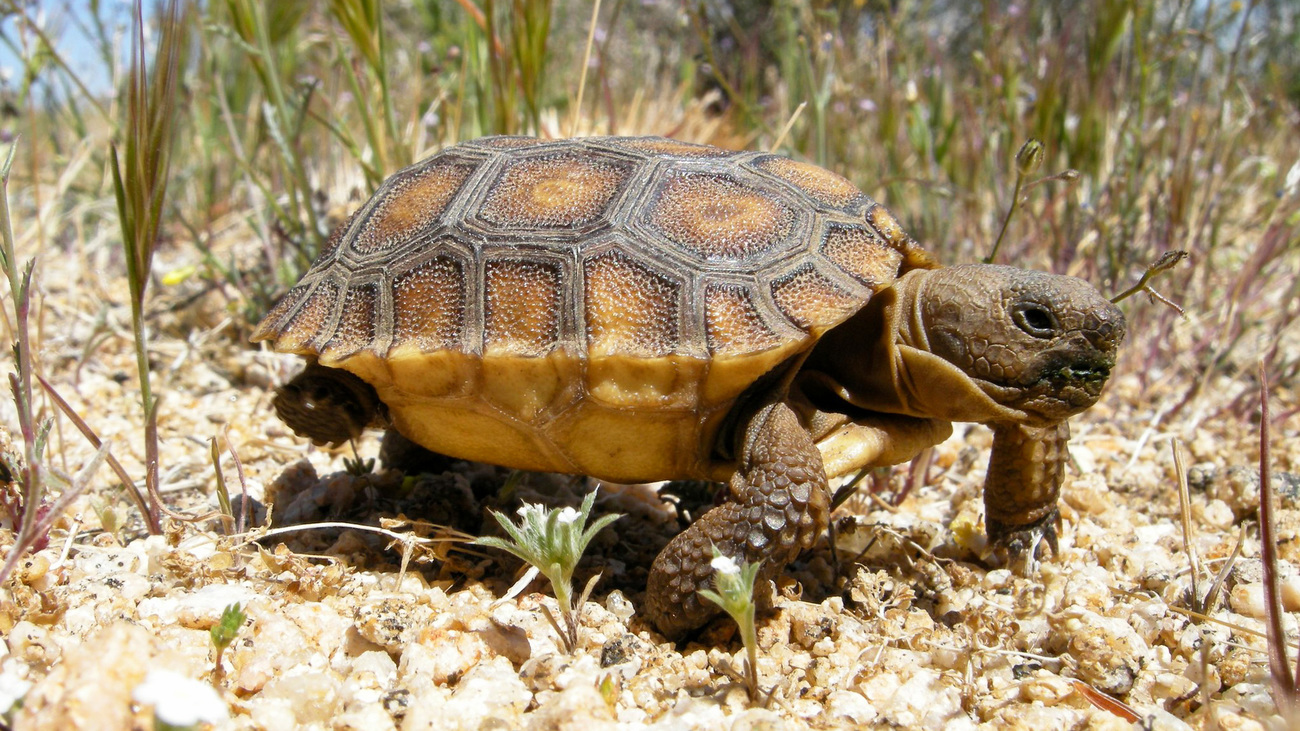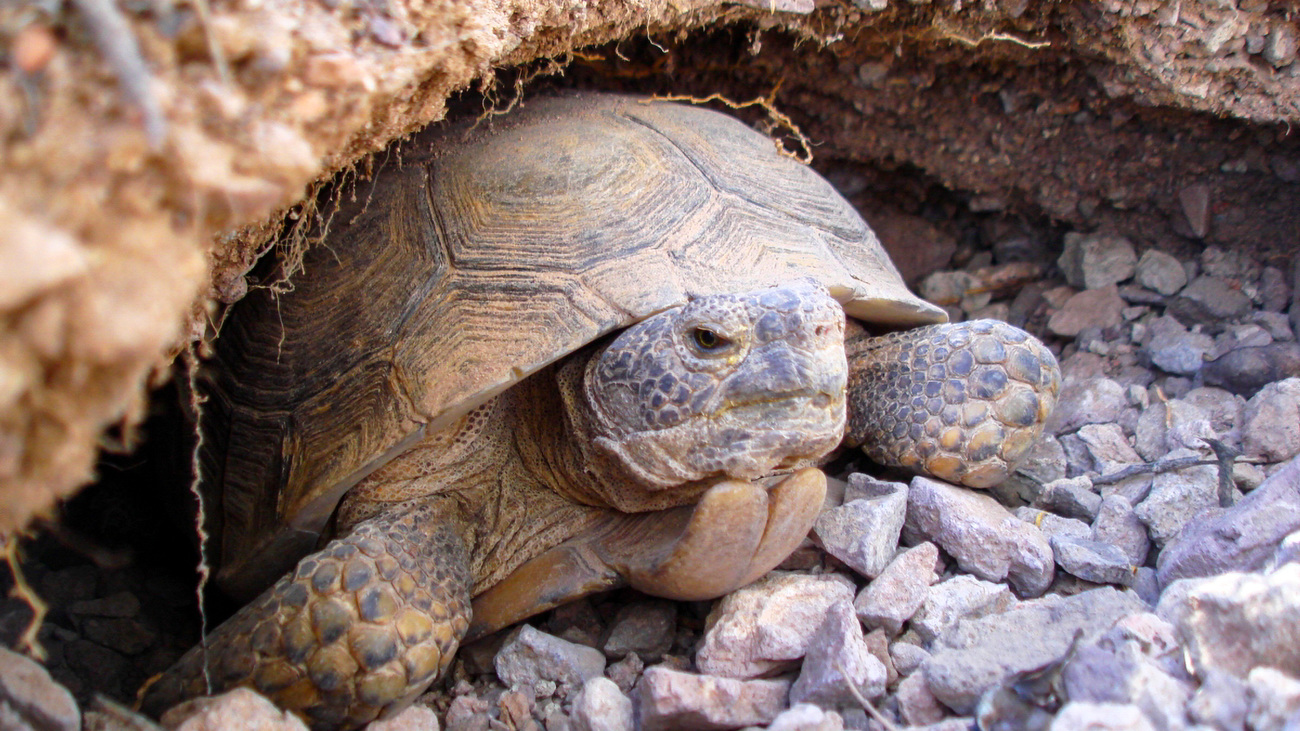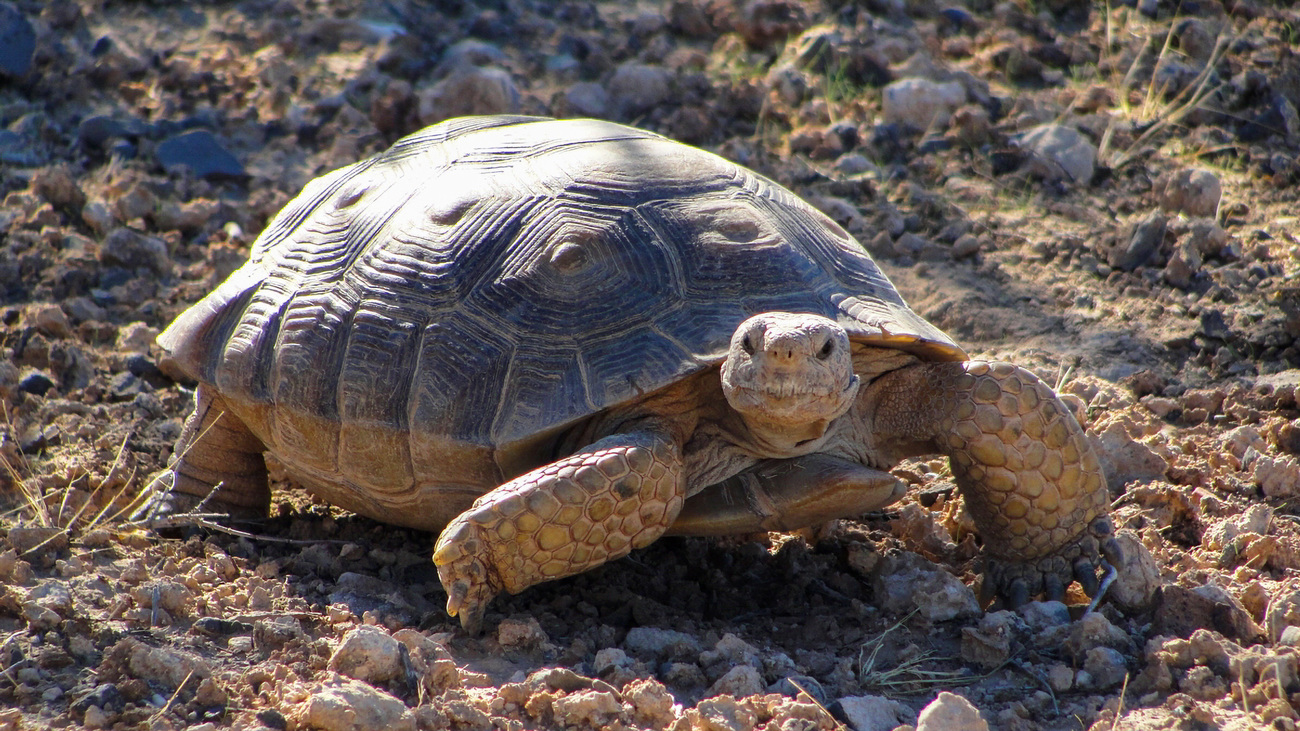Desert tortoises
The desert tortoise is a remarkable reptile that has thrived in the harsh Mojave Desert ecosystem for millions of years. These resilient creatures play a vital role in their environment and have unique adaptations that enable their survival in extreme desert conditions.
The desert tortoise belongs to the family Testudinidae, which includes all tortoise species. Within this family, desert tortoises belong to the genus Gopherus. There are two distinct species of desert tortoise: Agassiz’s desert tortoise (Gopherus agassizii), found in the Mojave Desert, and Morafka’s desert tortoise (Gopherus morafkai), found in the Sonoran Desert.
Desert tortoises are medium-sized tortoises, measuring 23-38 centimeters (9-15 inches) in length when fully grown. They have a high-domed shell called a carapace, which provides protection from predators and the harsh desert environment.
Males exhibit unique features that differentiate them from their female counterparts. They possess longer gular horns at the front part of their shells, larger tails, and concave plastrons (lower shells). This is an adaptation facilitating mating activities. Male desert tortoises also display a range of shell colors, varying from greenish-tan to dark brown.
These tortoises have stocky, elephantine legs, perfect for crawling over rocky terrain. Male desert tortoises have longer tails and concave undershells compared to females. On average, desert tortoises weigh 3.5-7 kilograms (8-15 pounds) as adults. Newly hatched desert tortoises, called hatchlings, are much smaller—only 5-7.5 centimeters (2-3 inches) long.
Desert tortoises have lifespans of 30-50 years in the wild. Some desert tortoises have even been recorded to live for over 80 years. This long lifespan is made possible by their slow metabolism and resilient adaptations.
Desert tortoises are found in the Mojave and Sonoran deserts of southwestern North America. Their geographic range includes southeastern California, southern Nevada, southwestern Utah, and western Arizona, as well as the Mexican states of Sonora and Sinaloa.
Within these areas, desert tortoises occupy a variety of arid habitats including desert scrub, grasslands, sandy flats, and rocky slopes. They can be found at elevations from sea level to around 1370 meters (4,500 feet). Desert tortoises prefer firm soil for burrowing, sparse, low-growing shrubs for shelter, and sunny areas for basking. They avoid rocky terrain as it makes movement difficult.
In addition to their long lives, they also mature at a slow pace, taking up to 13-20 years to reach reproductive maturity. Mating occurs in the spring and fall, when male tortoises compete for access to females. Several males may pursue a female in ritualized aggression that involves ramming and biting. A female desert tortoise lays a clutch of 1-12 eggs in an underground nest, often near the mouth of its burrow. A desert tortoise may produce up to three clutches per season.
The eggs incubate for 70-120 days before hatching in late summer or autumn. Hatchlings emerge from the nest and begin life on their own with no parental care. Their tiny shells are soft at first but harden within a few weeks. Young desert tortoises face many threats early on, including predation, dehydration, and starvation. If they are able to survive and reach adulthood, they are likely to live a long life.
In terms of diet, desert tortoises are herbivores and feed on a variety of plants. Their diet includes native grasses, herbs, shrubs, and cacti. Some of their favorite foods are bladderpod, desert dandelion, primrose, Joshua tree flowers, and cactus fruits. Desert tortoises will also sometimes consume rocks, soil, and animal droppings to supplement their diet with minerals.
They are also excellent burrowers, using their strong forelimbs to dig deep shelters up to nine meters (32 feet) long. These burrows provide a refuge during hot summers, cold winters, and even wildfires. Often, they share these burrows with other reptiles like lizards and snakes.
During the hot and dry summer months, desert tortoises become inactive and spend up to 95% of their time in their burrows. This state of inactivity is called estivation and enables them to conserve water and energy. They emerge to feed and drink in the cooler seasons of spring and autumn when annual plants are growing.
Tortoises can go for up to a year without access to fresh water, relying on the water contained in the plants they consume. To survive in a desert climate, with extreme temperatures and scarce water, desert tortoises exhibit many unique behaviors and adaptations that enable their survival.
Their slow, lumbering walk is one of these adaptations that helps them reduce water loss, as does their ability to seal their legs and head into their shell. Another way they retain fluid is by producing urine with high levels of uric acid and then reabsorbing water from their bladder to rehydrate. All these adaptations help desert tortoises survive on limited water in their arid environment.
Desert tortoises are ecosystem engineers, which means they play an important role in holding their ecosystems together. As well as using their burrows to protect themselves from the harsh climate, the other reptiles that share their burrows rely on them for the same purpose.
Seed dispersal is another reason they are important to their ecosystems. As they consume vegetation and excrete seeds during movement, new plants get an opportunity to grow in different areas. This contributes significantly towards biodiversity.
Desert tortoises are important to southwestern Native American cultures. Indigenous peoples have had a close spiritual connection with these reptiles for centuries. Desert tortoises served as a food source to tribes like the Mojave and Seri, and their shells were used decoratively and ceremonially. According to Mojave mythology, the desert tortoise helped humans during creation by uprooting plants.
What is a desert tortoise’s scientific name?
The desert tortoise is known by many different names, including the Mojave desert tortoise, California desert tortoise, Sonoran desert tortoise, and Agassiz’s desert tortoise. Gopherus agassizii is the scientific name for Agassiz’s desert tortoise, also known as the Mojave desert tortoise or California desert tortoise. Morafka’s desert tortoise—also called the Sonoran desert tortoise—is the species Gopherus morafkai.
Are desert tortoises endangered?
Yes, according to the International Union for Conservation of Nature (IUCN), Agassiz’s desert tortoises are critically endangered. Morafka’s desert tortoise has not yet been assessed by the IUCN.
Where do desert tortoises live?
As the name suggests, the desert tortoise habitat is mainly in desert regions. They are native to the US and Mexico.
While they're most commonly associated with deserts, they can also inhabit deciduous forests and grasslands. In California specifically, desert tortoises tend to occupy open washes within creosote-bush flats.
The Sonoran desert tortoise (Morafka’s desert tortoise) lives in the Sonoran Desert—east of the Colorado river in Arizona, as well as in the states of Sonora and Sinaloa, Mexico. Agassiz’s desert tortoise lives in the Mojave and Sonoran Deserts—in western Arizona, southeastern California, southern Nevada, and southwestern Utah, as well as northwestern Mexico.
Threats
Unfortunately, there are a number of different threats that have led to the critically endangered status of desert tortoises. Two of the main threats are human activity and habitat loss.

Human activity
The desert tortoise has seen its population dwindle by a staggering 90% since 1950. This dramatic drop can largely be attributed to human activity. As our own populations grow and sprawl outwards, we encroach upon the desert tortoises' habitats. Buildings replace open land, vehicles drive through areas that were previously undisturbed, and cattle introduced into these regions consume vegetation that is crucial for the tortoises’ survival.
Domesticated animals pose another threat. Dogs allowed to roam freely can harm or kill desert tortoises, while other pets attract predators. The spread of human garbage can attract scavengers, too, which also increases predation risks for the desert tortoise.
Tourism brings increased foot traffic from hikers and visitors eager to see this unique creature in its natural habitat, which often results in unintentional disturbances. Off-road recreational vehicle activities are particularly damaging. Tortoises may get crushed under wheels or see their burrows destroyed beneath them.
In Mexico, overharvesting for meat and oil poses a significant threat, while illegal dumping introduces toxins harmful not just to individual tortoises but entire populations by contaminating their habitats.
Poaching continues to be a problem, despite being illegal. The pet trade affects desert tortoises, and their eggs are falsely believed to have aphrodisiac properties. This has led to the further depletion of an already dwindling population.
Habitat loss and degradation
The expansion of human societies through residential developments, agricultural expansion, and industrial activities all contribute to habitat loss for desert tortoises, but there are also other ways that their habitats are being damaged or destroyed.
Invasive grasses pose a problem for desert tortoise habitats. Invasive grasses are non-native species that can alter the delicate balance of the desert ecosystem by outcompeting native plants that serve as food sources for tortoises. Additionally, invasive grasses increase fire risks, which can cause widespread habitat destruction.
Human-made barriers like walls and fences can lead to tortoise habitats becoming fragmented, isolating populations in the process. This generally makes breeding more difficult and reduces genetic diversity among populations. Tortoises have a slow reproductive rate with long periods of fertility, which exacerbates this issue further.
The threat of a changing climate adds another layer of complexity to this problem. Increasing temperatures may create environments that are unsuitable for tortoise habitation, affecting both reproduction and survival rates.
Conservation efforts aimed at mitigating these issues have been relatively slow in development, but there are some promising initiatives. The idea of private adoption programs on protected land has been raised, designed specifically for desert tortoise preservation.
FAQs
What do desert tortoises eat?
The desert tortoise diet primarily consists of grasses, flowers, fruit, and cacti. As herbivores in an arid environment, these plants play a dual role, providing essential nutrients and also serving as a crucial water source, allowing them to remain hydrated despite their desert habitat’s challenges.
How many desert tortoises are left in the world?
It’s difficult to know exact numbers for the desert tortoise population due to their sporadic distribution, combined with inherent difficulties in detection. Their decline is particularly evident in areas outside designated recovery zones like California. Population densities outside these zones have shrunk to alarming levels—approximately two to three adults per square mile.
How much does a desert tortoise weigh?
On average, a desert tortoise weighs between 3.5-7 kilograms (8-15 pounds), although individual weights can vary based on age, diet, and environmental factors.
How big are desert tortoises?
An adult desert tortoise typically measures 23-38 centimeters (9-15 inches) in length. When hatchlings are first born, they are much smaller, about 5-7.5 centimeters (2-3 inches) in length.

How long do desert tortoises live?
While most desert tortoises live for about 30-50 years, some have lived for over 80 years. This impressive longevity usually occurs in environments with fewer threats and more abundant resources.
Do desert tortoises hibernate?
Rather than hibernating, desert tortoises practice estivation. During the intense summer heat, they burrow deep underground, effectively reducing their physiological activity. This tactic allows them to conserve energy and vital resources while avoiding the scorching desert temperatures above.
Can a desert tortoise swim?
No, desert tortoises can’t swim, unlike the many turtles adapted for aquatic environments. Turtles possess unique physiological features, like flippers and water-optimized feet, which enable effective swimming. In contrast, desert tortoises have bent legs equipped with clawed toes designed for traversing on land. Their heavy, domed shells also make them unsuitable for swimming.
How are desert tortoises affected by climate change?
The ramifications of climate change are profound for the desert tortoise. With escalating habitat destruction and degradation, their native food sources become increasingly scarce. The rise of renewable energy projects is also having a negative effect. Even though they are environmentally beneficial in many ways, they sometimes lead to further habitat fragmentation. As climate change intensifies, these challenges compound, posing even greater threats to the desert tortoise's survival.

How can you help?
Desert tortoises are facing habitat loss due to human activity, and climate change also presents a looming threat to their survival. Learn more about how IFAW is working to combat these issues around the globe.
